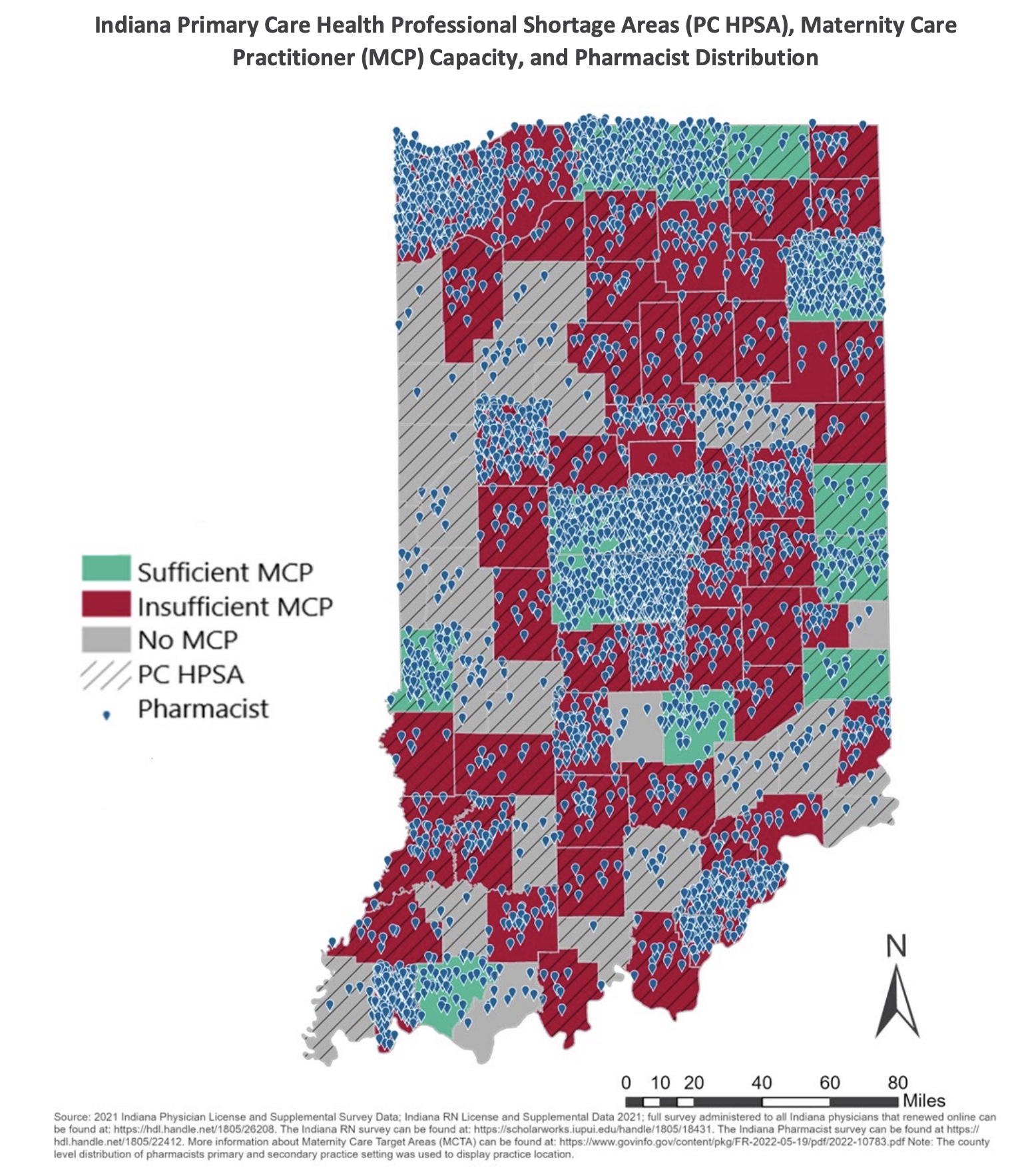The Bowen Center believes in the power of data to support informed policy.
Workforce data provides valuable insights regarding trends in and dynamics of supply, pinpoints where shortages exist and informs emerging workforce models which aim to fill gaps. The Bowen Center supports Indiana’s efforts to collect data on licensed healthcare occupations. When health professionals renew their Indiana license, they provide supplemental information through a series of questions structured to capture data needed to inform state policy, such as: where they practice, how many hours they work, demographics, and their plans for the future. Our team partners with the state to transform these data into reports and briefs that (we hope) promote a better understanding of Indiana’s health workforce, the strengths, challenges, and where opportunities exist to fill gaps.
Recently, we were approached to provide data insights on the contraceptive care workforce – where Indiana had potential contraceptive care providers, and where there were gaps. These data were used to inform 2023 House Enrolled Act 1568. This bill expanded the role of trained pharmacists by allowing them to prescribe hormonal contraceptives to adult women, a service that was previously held by traditional prescribers – generally physicians, advanced practice registered nurses, and physician assistants. Lawmakers wanted to understand the potential impact on access to contraceptive care if pharmacists were granted the ability to contribute as prescribers.

Leveraging workforce data, the Bowen Center generated a policy brief and map that examined the distribution of primary care and maternity care practitioners and pharmacists across Indiana. The map revealed that pharmacists were spread out more widely across the state than primary care and maternity care practitioners, with at least one pharmacist practicing in every one of Indiana’s 92 counties, including within counties that are underserved by traditional contraceptive prescribers. Supporters of the legislation used this map during debate in the statehouse, and backed by evidence, HB 1568 successfully passed through the legislature and was signed into law by the governor. More information about the methodology and findings from this research request can be found in our accompanying brief.
What makes Effective Data?
In fulfilling this data request, we realized this exercise might provide us an opportunity to share our thoughts on the “values” that a dataset might hold in order to be used most effectively to support informed policy.
1. Timeliness and Accuracy.
It is crucial to use the most up-to-date information to have a current understanding of labor market conditions. Outdated or inaccurate data can lead to decisions based on flawed information.
The supplemental data used for the Bowen Center’s primary care, maternity care, and pharmacist map were collected within the last two to three years, ensuring its relevancy. Physician and APRN data came from the 2021 license renewal cycle, while pharmacist data was sourced from the 2020 report. To identify primary care shortage areas and maternity care capacity, a trusted federal source, the Health Resources & Services Administration, was utilized.
2. Relevance.
Workforce data analysis should align with the strategic goals and priorities of the inquiry and should provide actionable insights that can help improve stakeholder understanding without the addition of extraneous data points. This means that the data should be sufficient to provide an understanding of the workforce’s capacity and capabilities with the minimum amount of information needed to answer the research question.
In the case of the policy relevant inquiry related to contraception prescribing, the quick turnaround map was created to gain a better understanding of the issue. The map included only relevant data, designed to be easily comprehensible “at a glance.” Each data element in the map contributed to answering the central question: Might access to contraceptives be impacted if pharmacists were permitted contraceptive prescribing privileges?
3. Comprehensiveness.
To maximize the utilization of data, it is ideal to have a complete picture of the workforce that addresses the initial query. It’s important to consider all the necessary information that contributes to an accurate understanding of workforce distribution.
Indiana’s practice of collecting supplemental data during the licensure renewal process provides essential workforce information that would not be gleaned from the license renewal data alone. Without this additional data, Indiana would be unable to identify such elements as practice location, FTE and practitioner specialty, severely hampering a comprehensive understanding of the workforce in Indiana. From this valuable supplemental data, we were able to incorporate both primary care and maternity care capacity as separate mapped elements since both groups can prescribe hormonal contraceptives. By including all significant workforces, we assure that the take-away is a comprehensive depiction of the current state of relevant healthcare in Indiana.
4. Balance of Granularity and Aggregation
Data should strike a balance between being detailed enough to capture the nuances of the workforce landscape and providing an overview of the bigger picture.
The policy map achieved this balance by using both granular and aggregate data in a user-friendly format. Indiana Primary Care Health Professional Shortage Areas and Maternity Care Practitioner capacity were aggregated across counties using two different visual tools, while pharmacist data was presented more granularly with individual pinpoints for each practice location. This allowed for a quick understanding of workforce capacity in specific areas without losing sight of the broader workforce gaps.
Research and data analysis are vital components of the policy and legislative process. Data analysis that is carefully considered and displayed in a user-friendly way can play an important supporting role in policymaking by providing actionable, evidence-based insights. The successful passage of House Enrolled Act 1568-2023 in Indiana demonstrates that data-driven approaches can help policymakers make informed decisions that can positively impact the health and well-being of people in the state. Ultimately, it contributes to the delivery of comprehensive, high-quality healthcare. At the Bowen Center, we are honored to be able to provide data that empowers Indiana policymakers.

